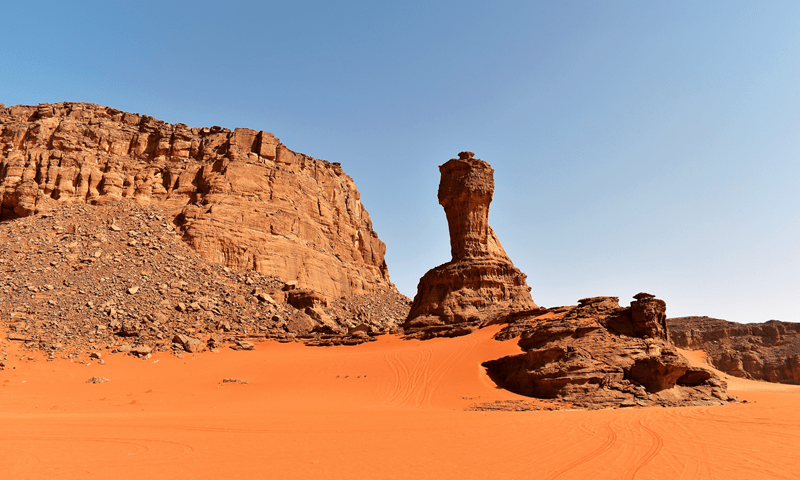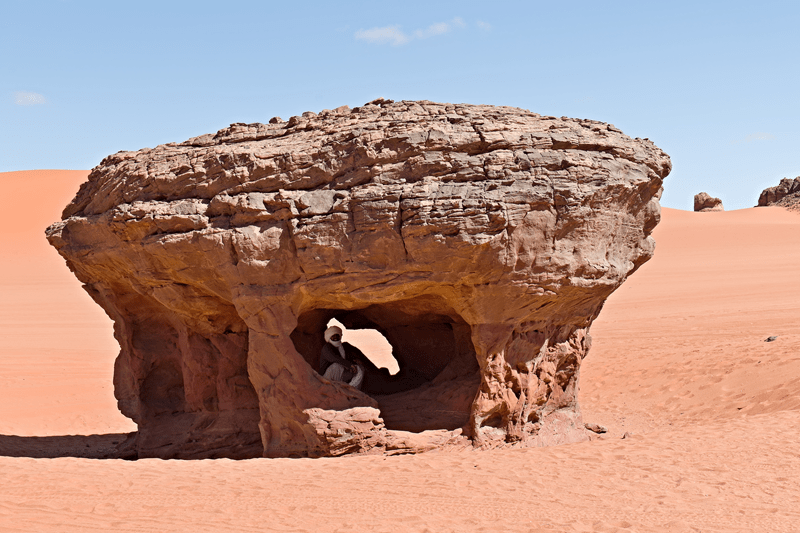
In the extremely southern part of Algeria, where the sun bakes the earth and wind has molded the land into the most improbable shapes, is perhaps the world’s most incredible open-air museum. The Tassili n’Ajjer is a large sandstone plateau in the Sahara Desert that offers more than the typical desert hikes in Algeria. It affords a thoughtful pilgrimage into our collective record as humankind. A Tassili n’Ajjer hike is not a frivolous walk; it is a passageway through millennia, where each canyon or cave speaks in whispers of a time when this dry space was a thriving paradise.
This UNESCO site, which Algeria protects with great pride, is a complex and perplexing series of rock forests, natural arches, and one of the most extensive compilations of prehistoric art in the world: the famous Tassili rock art. This article serves as a primer for planning and executing a transformative adventure across this majestic plateau, starting in the oasis town of Djanet and moving to silent nights beneath the Saharan sky, filled with stars.
The Tassili n'Ajjer literally translates to "Plateau of the Rivers" and is a truly enormous geological formation. Part of the allure of hiking on the Sahara plateau lies in its surreal dimension. Picture a land of eroding sandstone that resembles a petrified forest, with towering pillars, deep gorges, and vast, sandy expanses. Over the course of millions of years, this land has been shaped by running water and erosive wind, carving out a natural fortress that continues to intrigue those who traverse it and safeguard its ancient remnants.
It is the same geography that makes hiking in Tassili n’Ajjer a demanding activity, which has also shielded its priceless archaeological treasures for thousands of years from easy access. This will continue to preserve them for the brave few who take on the journey.
The essence of any hike in Tassili n’Ajjer is the engagement with an amazing archaeological legacy. The Tassili rock art is an unmatched array of thousands of paintings and engravings that chronicle the remarkable climatic shifts and the dynamic changes in human existence in the region, dating from approximately 12,000 years before the Common Era to the early centuries of the Common Era.
The art is a timeline carved and painted onto the stone canvas of the plateau.
Observing these works of art in situ, in the very shelters where artists once lived and worked, is a humbling experience that connects you to the human story—the very essence of visiting this UNESCO site, which Algeria is committed to protecting.

The starting point for this adventure will be the tranquil oasis town of Djanet, located at the base of the plateau. All major Tassili n’Ajjer hiking itineraries originate from here and follow a historical network of paths called the Djanet trails. These trails are inherited from ancient times, with little to no changes made, and they have been used for millennia by the Tuareg people, the "Blue Men" of the Sahara, who take their rightful place as the guides and custodians of the land.
Planning well in advance is essential for a safe and satisfying adventure and is as follows:
These routes in Djanet form your way into another world. Respecting the logistical requirements of a trek keeps you safe and allows for a deeper engagement with this place.
Hiking in Tassili n’Ajjer is more than just walking. It is a profound experience felt in the mind, body, and soul. The emptiness of the desert is both a powerful meditation and a reminder of that emptiness, punctuated only by the sounds of the wind and the soft crunch of the earth beneath your feet. The lack of light pollution from civilization means that, on clear nights, you’ll observe a spectacular display of stars that few will ever witness.
You are engaging with the Tuareg Guides, whose knowledge of the desert and its history, as well as their survival skills, is good common sense. Tuareg hospitality and stories told by the flickering light of the campfire enrich this experience with a compelling cultural context. What was once merely a walk in the desert has turned into an actual exchange among humans.
Walking in the desert of Algeria is an experience of both an outer and an inner journey—something many don’t get to immerse themselves in any longer. The experience of walking the Tassili inspires a complete disconnection from contemporary life and fuels a reconnection with something ancient yet essential to our humanity. The accessibility of Tassili rock art and the ancient natural landscape of the Sahara plateau allow for unique tales of persistence across ages and over time.
A Tassili n’Ajjer hiking expedition is an unforgettable immersion into a prehistoric world. Traversing the dramatic Sahara plateau from the Djanet trails, you witness the profound legacy of Tassili rock art, a treasure of this UNESCO site. These desert hikes in Algeria offer more than scenery; they provide a tangible connection to ancient humanity, leaving every traveler with a profound sense of wonder and a story etched in memory forever.
This content was created by AI